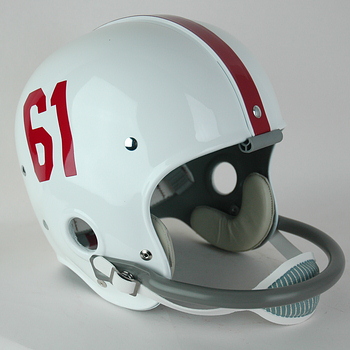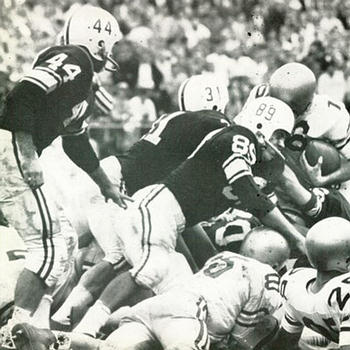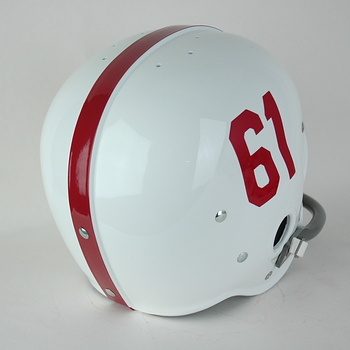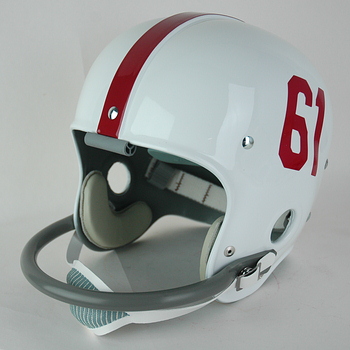

Alabama
1957-71 Crimson Tide
(Authentic Reproduction)
 |
 |
 |
 |
 |
 |
Whitworth's final season proved no better than his first two with another 2-7-1 record. Dave Sington performed extremely well at tackle as did Billy Rains at guard but once again, the team did not play up to SEC standards and the finale was a galling 40-0 disaster against rival Auburn. Whitworth's 0-3 record and ineptitude against the hated Auburn Tigers was reflected in the aggregate 100-7 point differential in those three games in which he led the Tide against their despised rivals. Adding cardinal player numerals to both sides of the white helmets with its one-inch cardinal center stripe gave the Tide a sharper look in '57, but the lack of competitive play spelled the end for Whitworth, a coach considered to be an extremely nice man but one who could not get his teams to play tough and resilient football. Whitworth's exit led to the hiring of Paul Bryant and an era of Alabama football that became one for the ages. The only reminder of the Whitworth years would be his final year’s helmet design as it was utilized as the primary helmet style until the 1961 season and pressed into service for specific games as late as the October 23, 1971 contest against Houston. Whitworth returned to Georgia as their line coach and was considered effective in their 1959 SEC Championship season. Tragically, he suffered a fatal heart attack in 1960.
After the 0-10, and two consecutive 2-7-1 seasons under head coach Whitworth, the Alabama faithful were ready to go all out to have a winning team in 1958. Paul "Bear" Bryant was raised in rural Moro Bottom, Arkansas and helped his Fordyce High School team to the 1930 State Championship. At Alabama he was an integral part of the 1934 National Championship team before becoming a staff assistant. He moved to a spot on “Red” Sanders Vanderbilt staff and then entered the U.S. Navy after the outbreak of WW II. He established his coaching reputation at North Carolina Pre-Flight and upon his release from the service became the head coach at Maryland. After only one season, a successful one, he was forced out in a power struggle with the university president and was hired at Kentucky. Long in the shadow of its successful basketball program, Bryant established Wildcat football as a force but took the Texas A&M rebuilding job in 1954. His infamous “Junction Boys” pre-season training camp earned him a national reputation as a hard-nosed taskmaster and he produced top Southwestern Conference teams and 1957 Heisman Trophy winner John David Crow. At the time of his Alabama hiring, the chairman of a special search committee stated, “We have secured, to our way of thinking, the best football coach in the country for the position of head football coach at the University Of Alabama.” In turn, Bryant signed a ten year contract to assume both the athletic director and head coaching positions and stated that as difficult as it was to leave the very successful program he had built at A&M, “…the most difficult thing I have ever had to do,” he had good reason to do so. “The reason, the only reason I’m going back is because my school called me.” He downplayed his coaching abilities, stating “I’m just a simple plow hand from Arkansas but I have learned over the years how to hold a team together. How to lift some men up, how to calm others down, until finally they’ve got one heartbeat, together, a team.” Seeking out players with the type of background he had come from, poor, rural, and willing to work as hard as possible to move forward in life, Bryant felt that he had the unique opportunity to rebuild the football fortunes at his alma mater. His initial group was re-made in his image as lung-busting running and drill sessions leaned out and mentally toughened a marginally talented squad which finished the 558 season at 5-4-1. Bryant knew he would be successful if he could get the material and as he put it, "teach your kids to forget a losing complex." Quick-kicks, field position, and brutal defense, one that surrendered but seventy-five points, defined his new Crimson Tide teams.
Bryant maintained the white helmet with one-inch cardinal center stripe and cardinal identifying numerals for 1958, ’59, and 1960 but the team otherwise looked new and improved in every way. Behind sophomore quarterback Pat Trammell the 1959 Tide went 7-2-2 and most importantly beat Auburn for the first time since 1953. The Tide's winning field goal was kicked by Tommy Brooker who would win further acclaim in the pros with his overtime winning boot in the sixth quarter of the overtime 1962 AFL Championship Game for the Dallas Texans. The victory over Auburn put the Tide into the first of twenty-four consecutive bowl appearances under Coach Bryant. The brand new Philadelphia-based Liberty Bowl paired Penn State and the Tide and though the 7-0 contest was a loss, it gave Alabama its first national exposure in decades. There would be more to come as All SEC tackle Billy Neighbors led the way for Trammell who was the conference total offense leader, rushed for 500 yards, and was exactly the fiery point man Bryant was seeking. However, what would become the trademark for Alabama teams throughout the Sixties was evident in ’59 as the stifling defense finished first nationally against the pass and number four in total defense while shutting out four, and holding another five opponents to only a touchdown while giving up a season’s total of fifty-nine points. Fans were delirious as the final AP Poll noted Alabama as number ten!
Bryant's 1960 team was loaded with youngsters who would later make a
name for themselves as NFL players or college coaches and his team
was defining defense in a way that was making everyone throughout
the south re-think their approach to the game. Five shutouts, a
total point yield of fifty-six, an 8-1-1 regular season mark and a
3-3 tie against a favored Texas team in the Bluebonnet Bowl left
Bama ranked with the number two overall defense in the nation.
Quarterback Trammell again led the way, with back-up help from Bobby
Skelton who played in both the Southern and North American Football
Leagues for Alabama based teams. Typical for Bryant contingents,
most of the punch was provided by the defense although many
contributed on both sides of the ball. Tommy Brooker again was an
outstanding end as well as a dependable kicker. Speedster Ray
Abruzzese, a Hinds (MS) Community College transfer by way of his
hometown of Philadelphia, PA was a dependable two-way back and
halfback Leon Fuller who had the distinction of playing high school
football for Bum Phillips before playing his college ball for
Bryant, later became a well-respected college defensive coordinator
at Texas among other stops and was the head coach at Colorado State.
Fuller was later elected to the Southeast Texas Coaches Hall Of
Honor after a forty-two year coaching career. The end opposite
Brooker was Bill Battle. The big guns on the line were junior guard
Billy Neighbors who was a Second Team All SEC choice and
center/linebacker Lee Roy Jordan. Surprising their fans, Bama
entered the Bluebonnet Bowl wearing cardinal helmets with a one-inch
white center stripe and white identifying numerals on the sides of
the helmet, a look that was to become immediately linked to the
Crimson Tide as specifically "theirs." Although the white helmet
would be utilized in specific games or for specific pass-eligible
players, a major helmet change was coming.
If interested in any of these Alabama helmets please click on the photos below.